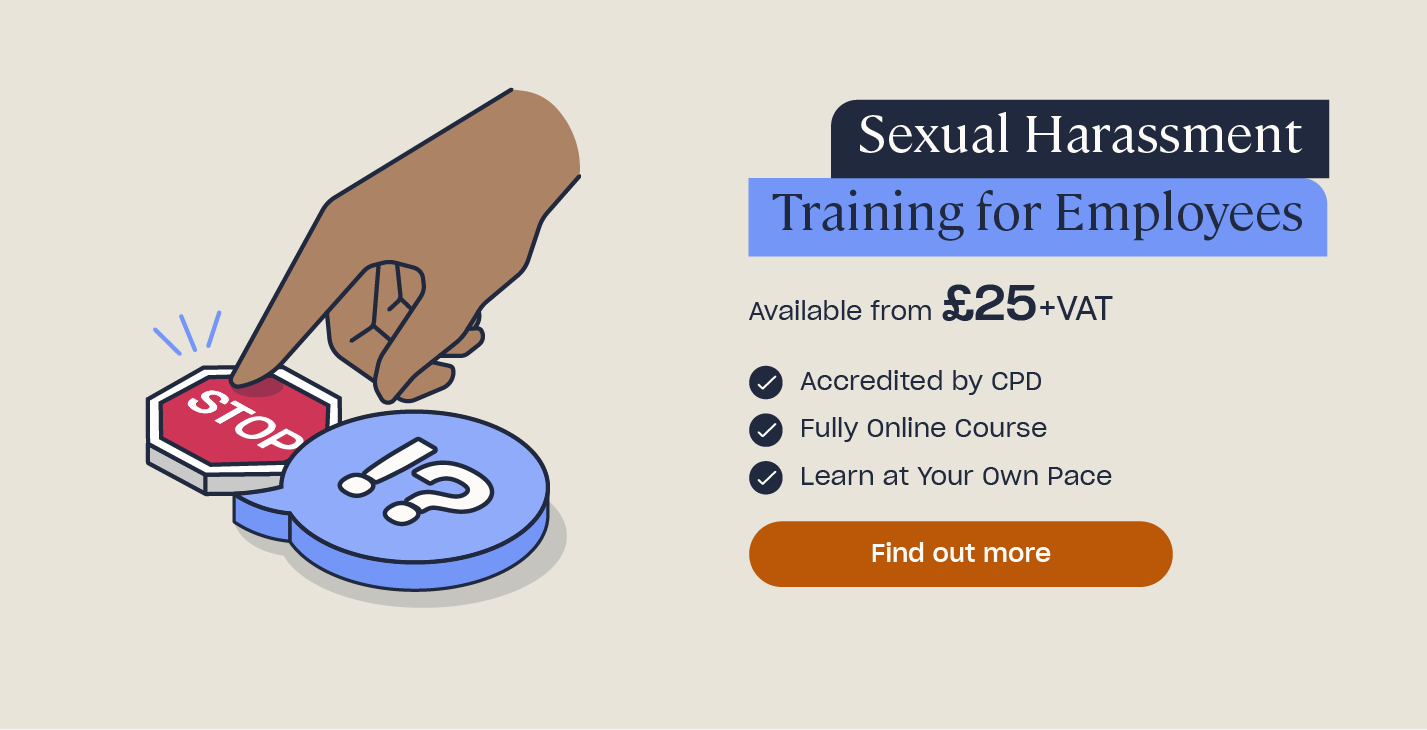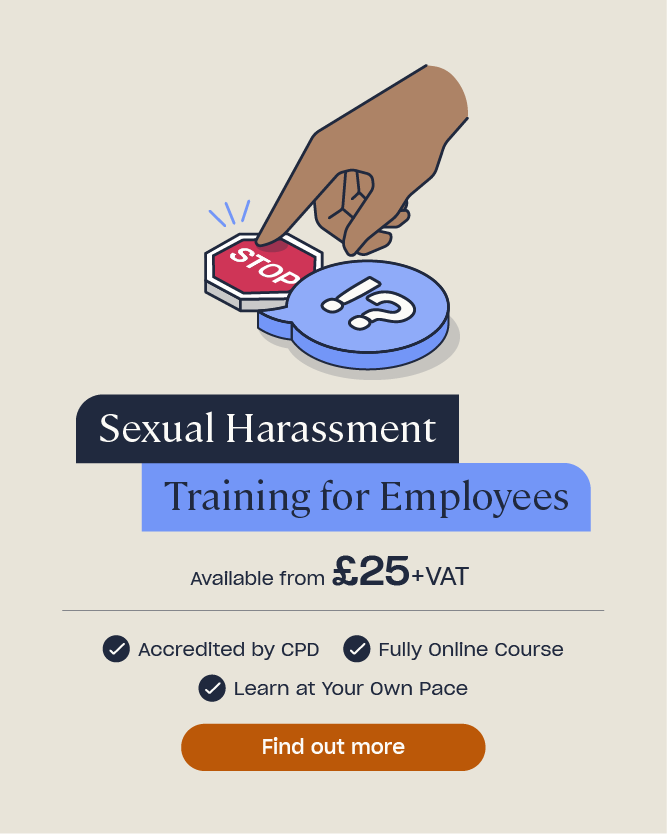Sexual Harassment in the Workplace: What Is It and How Do I Report It?
Sexual harassment is experienced all too frequently, from lude comments on the street, inappropriate staring on public transport to unwanted sexual jokes in the workplace. According to the 2020 Sexual Harassment Survey, produced by the Government Equalities Office, 29% of the participants in employment experienced some form of sexual harassment in their workplace or work-related environment within the previous 12 months.
In this article, we will explain what sexual harassment is, what behaviours it involves and how to spot the signs that you or one of your colleagues may be being sexually harassed. We will also provide you with guidance on how to respond to and report sexual harassment in the workplace.
What is Sexual Harassment at Work?
Sexual harassment is any unwanted behaviour of a sexual nature that is offensive or makes you feel uncomfortable, humiliated, distressed, degraded or intimidated. It creates a hostile and offensive environment. Even if it isn’t directed at you and was unintentional, something that makes you feel this way is still sexual harassment.
Sexual harassment can happen to anyone, regardless of gender identity, sexual orientation, disability, age or ethnicity. Although, identifying with one or more of these characteristics can impact how likely you are not only to experience it, but also to report it. The 2020 Sexual Harassment Survey shows of the 29% who experienced sexual harassment in the work place, higher instances were recorded for those within the following demographic groups:
- Women.
- Aged between 25-34.
- Ethnic Minorities.
- LGB.
- Highly limiting disability.
There was only a marginal difference between the number of men and women who had experienced sexual harassment in the workplace, and between white and ethnic minority persons. However, the greatest difference was found between the heterosexual and LBG groups as well as those with a highly limiting disability and those without.

The same is also true for those who commit sexual harassment in the workplace, in that the perpetrator is not always a certain gender or age, nor is it necessarily someone in power. Often, colleagues and clients can be responsible, particularly during social events or out of office interactions.
It is incredibly important to understand that whilst sexual harassment has, in the past, primarily focussed on the harassment of women by men, that is certainly not always the case. Everyone should be listened to, respected and protected equally. The Equality Act 2010 protects all employees and workers, contractors and self-employed people hired to personally do the work, against sexual harassment at work – this also includes job applicants.
Even with the most robust policies and procedures in place, workplace sexual harassment can, and does, still occur.
Am I Being Sexually Harassed at Work?
For every occurrence of sexual harassment that is reported, many are not. There can be lots of reasons for this, but often it is because people don’t realise that the behaviour they are being exposed to is harassment. Also, they may worry that they won’t be believed, that it will affect their career or they may be reluctant to take it further if the perpetrator is a close colleague or their boss.
Sexual harassment doesn’t have to take place within the actual workplace for it to be a work-related issue. If a colleague was making you uncomfortable during the work Christmas party by making sexual comments about how you look in your outfit, is that something that should be brushed aside because it was out of hours and there was a drink or two involved? The answer is no. If it offended you or made you feel uncomfortable, humiliated, distressed, degraded or intimidated, then regardless of the circumstances, it should not be accepted or ignored.
There can be a lot of ‘banter’ within the workplace and some may see it as a bit of fun. The type of jokes and interactions can vary between industries, roles and the demographic of the workforce. Sadly, sexual harassment can often be disguised as ‘banter’ and those doing it may have no ill-intent. However, in situations where everyone else is laughing along, the affected person often questions whether it really is that big of a deal and whether or not they should just ignore it.
When it comes to asking yourself whether you are experiencing sexual harassment in the workplace, either directly or indirectly, think about the behaviour or comments that were made and focus on how they made you feel. Don’t focus on how anyone else reacted to it, where it took place or even who the source was. You have the legal right to be protected from workplace harassment and you should always voice any concerns you have to the appropriate person within your organisation.

Learning some of the common signs of sexual harassment can make it easier to spot when it might be taking place.
Signs of Sexual Harassment in the Workplace
Whilst not an exhaustive list, some common signs of sexual harassment include:
- Unwelcome sexual advances, touching and all forms of sexual assault.
- Sexual comments and jokes, both when you are the subject of the joke and when you’re not.
- Unwelcome non-sexual touching.
- Being pressured into sexual conversations.
- Displaying images of a sexual nature – such as posters, erotic calendars or as a background image on a computer.
- Sending unwanted messages via text, email or a company messaging system.
- Indecently exposing themselves.
- Invading someone’s personal space.
- Offensive comments on social media.
- Sharing personal photos or videos without consent.
- Unwelcome staring or looks.
- Intrusive questions about your private or sex life.
- Unwanted relationship attempts.
Always remember that you can report sexual harassment, regardless of whether you are the target of it. It is still harassment if it creates an offensive environment and makes you uncomfortable.
Want to Learn More?
It is vital that all employees understand what behaviours and comments constitute sexual harassment. Having that knowledge helps to prevent, avoid and stamp it out. Learn more by taking a look at our Online Sexual Harassment Training for Employees Course.
What to Do if You’re Being Sexually Harassed at Work
Everyone reacts differently to this kind of unwanted behaviour and everyone has the right to feel a mix of emotions when it happens. However, your organisation should have specific policies and procedures in place, so that the matter can be addressed in an appropriate and professional manner. Following the right steps can help to ensure that you receive the support you need and that an agreed outcome can be reached.
It would be helpful to make notes of any behaviour that you believe may be sexual harassment. Not only can this help with the accuracy of your report, but it can also help you to relay the information if you find your experience difficult to talk about. These notes could include:
- The behaviour/action/what was said.
- How this made you feel.
- The date(s) it happened.
- If anybody else has said they have experienced the same behaviour.
When trying to gather ‘evidence’ relating to the harassment, it is worth noting that caution should be used when it comes to recording someone without their permission or in secret. A person recording someone in this way, regardless of what is captured, could be guilty of breaking their organisation’s rules and the law surrounding data protection.
If you’ve experienced sexual harassment at work, you can make a complaint to your employer, who should handle it fairly, sensitively and always take each complaint seriously. Whilst those perpetrating sexual harassment in the workplace are responsible for their own actions, responsibility can also fall to the employer as they not only have a duty of care for the wellbeing of their employees, but, by law, they must also ensure they do all they reasonably can to protect them from sexual harassment.
This type of responsibility is known as ‘vicarious liability’. To understand this a little better, you may find it useful to read our related article: Preventing Sexual Harassment in the Workplace: Employer Responsibilities.

How to Report Sexual Harassment at Work
If you have experienced sexual harassment at work, it’s crucial to report the issue as soon as possible. This will not only put a stop to the issues you are experiencing, but it can help to prevent others from experiencing the same.
Making a report can feel daunting, especially if the harasser is somebody in a senior position of power or someone who you consider a friend and/or work closely with. However, if their behaviour makes you feel uncomfortable or degraded then you need to speak up and take steps to make a complaint so that the issue can be resolved.
Check Your Workplace’s Sexual Harassment Policy
Your first step should be to check your workplace’s sexual harassment policy. All employers should have a sexual harassment policy in place, which sets out how it aims to deal with harassment, how a complaint should be made and who it should be made to. This may be your employer, manager, supervisor, HR department or a local trade union representative.
Put Your Complaint in Writing
Even if you speak to someone in person, always put the complaint in writing too. Date it and keep a copy of it. By submitting a complaint in writing, as opposed to vocally, you have a backup of your complaint should somebody deny the complaint was made or fail to act.
You should send the complaint to whoever the sexual harassment policy says has responsibility. If, however, this is the person whom your complaint is about, take your complaint to somebody else in a senior position of authority.
Ideally, all claims of harassment should be handled in the workplace. You should receive the opportunity to fully explain your complaint and the resolution you want from it and be kept informed of what action is being taken.

The Grievance Procedure and Decision to Appeal
If your employer can’t handle the dispute informally, you can raise a grievance. After you initially make the complaint, your employer should investigate it and then a grievance hearing will follow.
If you would like support, a work colleague or trade union representative can accompany you to the hearing. Following the hearing, your employer should inform you of the outcome in writing without reasonable delay.
If you’re unhappy with the outcome of the procedure, you can appeal. The appeal hearing is similar to the grievance hearing, but it further investigates why you’re unhappy with the decision and considers any new evidence. You also have a right to have someone accompany you to this hearing.
Employment Tribunals
If you’re unhappy with the results of both the grievance hearing and the appeal hearing, you can take your complaint further.
You can contact ACAS to start early conciliation. This is a process in which both sides of a legal dispute try to reach an agreement before the case goes to an employment tribunal. If this fails, you can take your case forward to a tribunal as a last resort. It should be noted that there are time limits for making a claim to an employment tribunal, and this usually stands at three months minus one day from the date the incident occurred.
Whatever the circumstances, it is important to seek the advice and support needed to come to the right decisions for you. Having someone to talk to about your options, may lead you to decide not to make an official complaint, or it may help to identify incidents that qualify as a crime and require police involvement. Talk to your employer to ensure you know where to turn if you need further advice.
Sexual harassment in the workplace is never acceptable. It is still classed as harassment regardless of whether you were targeted directly, witnessed it or whether the unwanted comments and behaviour were intended to cause offence. Employers and employees alike should make a stand and call out any behaviour that causes a person to feel uncomfortable, humiliated, distressed, degraded or intimidated at work.
What to Read Next:
- Sexual Harassment Training For Employees
- Am I Being Bullied at Work? 12 Signs of Bullying in the Workplace
- Workplace Bullying and Harassment Quiz
- A Manager’s Guide to Preventing Sexual Harassment in the Workplace
- Abuse of Authority in the Workplace







